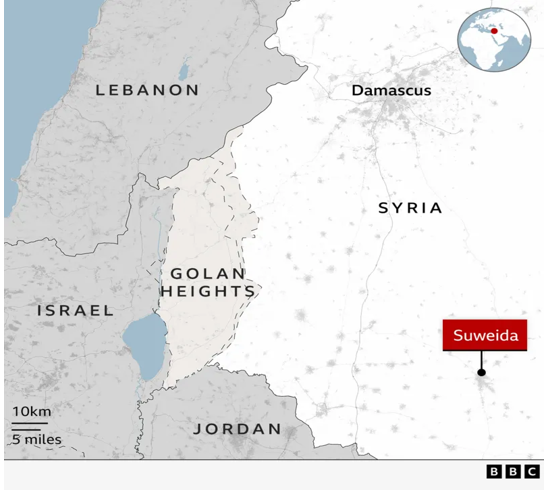Syllabus:
GS2: Effect of policies and politics of developed and developing countries on India’s interests, Indian diaspora.
GS3: Role of external state and non-state actors in creating challenges to internal security.
Context:
The reported abduction of a Druze merchant triggered several days of deadly clashes between Druze militias and Sunni Bedouin fighters in southern province of Al-Suwayda, Syria.
More on the News
- Following the collapse of Assad’s regime in December 2024 and the rise of interim president Ahmad al-Sharaa (a former terrorist known as Abu Mohammad al-Julani) ,Suwayda has become a flashpoint.
- Al-Sharaa’s past leadership of Hayat Tahrir al-Sham (HTS), a terror group, has heightened fears among Syria’s minorities. The Druze, in particular, see him as a threat.
- Israel intervened militarily, saying its forces were seeking to protect the Druze and to eliminate pro-government forces accused of attacking the Druze.
- The violence is the first in the Druze-majority province of Suweida since fighting in April and May between Druze fighters and Syria’s new security forces killed dozens of people.

Bedouin – Druze conflict is a result of the reignited sectarian divide
- Religious differences between Bedouins, who are Sunni Muslims, and the Druze who consider themselves non-Muslims, have been at the core of their mistrust, along with a history of animosity.
- Bedouins are decentralised and follow a tribal leadership, while the Druze have unified leadership, particularly under Sheikh Hikmat al-Hijri.
- Various state governments historically used one group against the other. And the post-Assad regime’s perceived favouritism toward Bedouins escalated tensions.
- Israel’s support for Druze communities, which is a minority group in the Jewish nation, inflamed perceptions of betrayal and foreign collusion.
Israel attacking Syria
- The most recent strikes have primarily acted as a warning and a deterrent against the Syrian army deploying to southern Syria, with Israel seeking to create a demilitarised zone in the area.
- In particular, Israel fears the presence of Islamist fighters near its northern border, along the Israeli-occupied Golan Heights.
- Since Assad’s fall in December 2024, Israel has seized more Syrian territory and launched repeated strikes to prevent military rebuilding and eliminate militant threats.
Druze
- The Druze are an Arabic-speaking ethno-religious minority in Syria, Lebanon, Israel and the occupied Golan Heights.
- The Druze faith is an offshoot of Shia Islam with its own unique identity and with distinct beliefs rooted in Islamic, Greek and other philosophical traditions are concentrated primarily in Suwayda and the mountainous Jabal al-Druze region.
- They have their holy text, the Rasail al-Hikma, or Epistles of Wisdom, although the Quran is also part of their theological framework. Tight ethnic and religious bonds hold the community together.
- Half of its roughly one million followers live in Syria, where they make up about 3% of the population.
- The Druze community in Israel is largely considered to be loyal to the Israeli state, owing to its members’ participation in military service.
- There are some 152,000 Druze people living in Israel and the Israeli-occupied Golan Heights, according to the Israeli Central Bureau of Statistics.
- They have historically occupied a precarious position in Syria’s political order.
- During Syria’s almost 14-year civil war, the Druze operated their own militias in southern Syria.
Bedouins:
- Bedouins fighting in Syria are not a singular entity, but multiple Arab tribes from the war-torn country’s desert regions, particularly the Badiya.
- Prominent among these Bedouin tribes are Baggara, al-Anezi, al-Mahamids, al-Qateifan, al-Saud, and al-Wahban.
- Once nomadic pastoralists, they are now living mostly semi-sedentary lives, but operate under kin-based tribal systems led by a ‘Shaykh.’
- Sunni Islam is a common denominator for the Bedouins, aligning with Syria’s majority sect.

